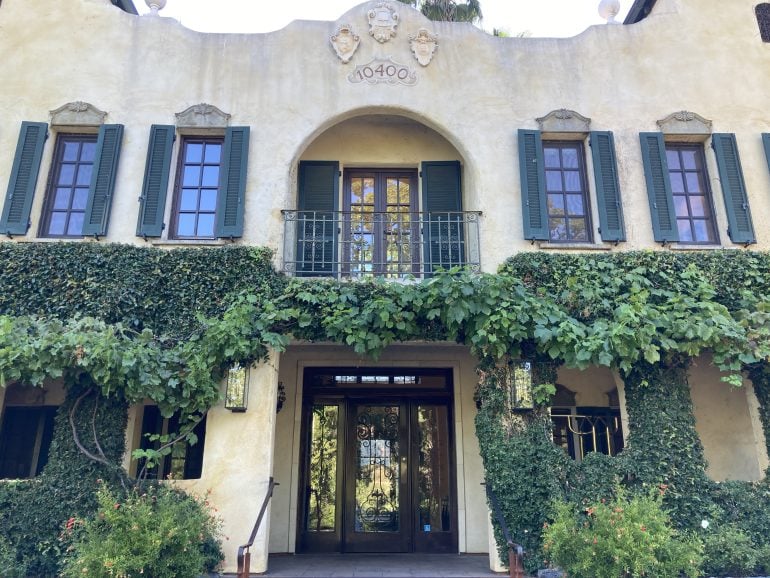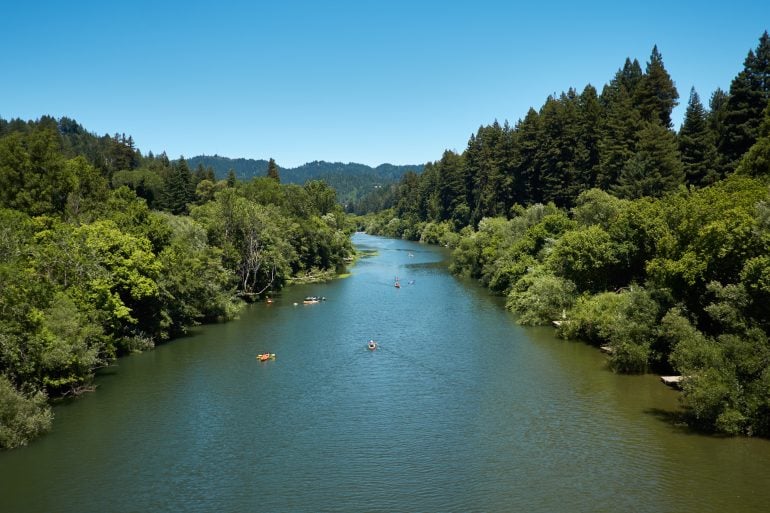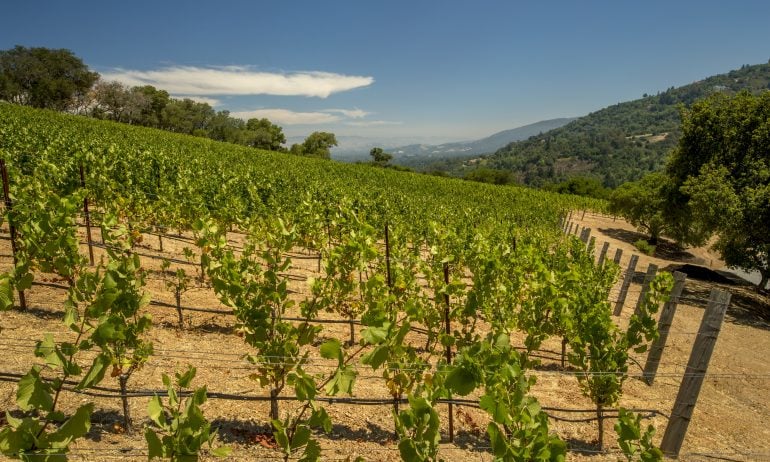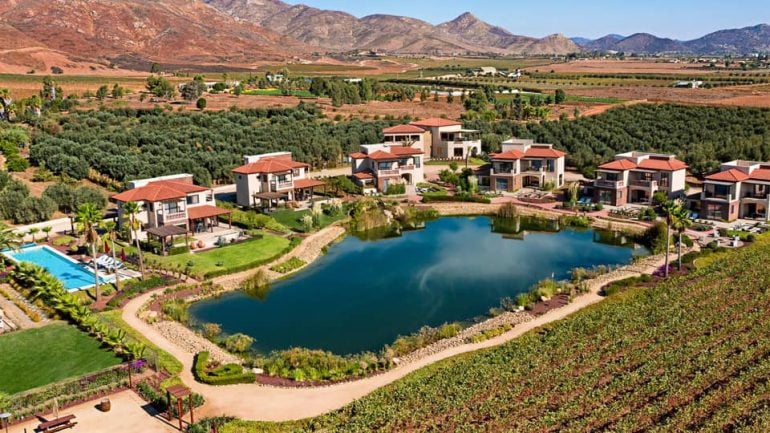10 Great California Wine Regions That Are Not Napa
Everyone knows Napa, but its neighbor, Sonoma, is often overlooked. Don't ignore Southern California's wine either.

Many or all of the products on this page are from partners who compensate us when you click to or take an action on their website, but this does not influence our evaluations or ratings. Our opinions are our own.
We all know about Napa. But what about the rest of California? Truth is, some of the world's best wineries can be found all throughout the Golden State.
From scenic Shasta to sunny San Diego, California produces 90% of the nation's wine — and does it well. For wine enthusiasts seeking to explore some of California's lesser known hot spots, check out these 9 wine regions in the state — and one more that's so close that we had to include it.
What's more is that most of California's wine regions beyond Napa are far more affordable, too.
1. Santa Barbara

Santa Barbara's Stearns Wharf
Santa Barbara is the star of southern California wine tasting, with more than 275 wineries fueled by a climate ideal for growing cool-climate grape varieties like Pinot Noir and Chardonnay. The region's vineyards are located in the Santa Ynez Valley, which is cooled by breezes from the Pacific Ocean, resulting in wines with elegant flavors and aromas. Most wineries are smaller, family-owned boutique wineries.
To get to the Santa Ynez Valley from downtown, expect about a 45-minute scenic drive through rolling vineyards of the Santa Ynez and Santa Maria Valleys. Once there, most wineries are free to visit, though you’ll usually pay per tasting (wine flight fees usually cost between $15 and $30, depending on the winery). Sometimes fees are waived with purchase.
If wineries aren't your thing, (or you just want to fill your day with more activities than simply wine tasting) there's plenty else to do in the Santa Ynez Valley and the broader Santa Barbara County. That includes Santa Ynez Valley's charming neighbor of Solvang, which is a charming Danish-inspired village known for its unique thatched roofs and windmills. Don't leave without trying the Aebleskiver, which is a puffy Danish pancake).
If you're visiting Santa Barbara but can't make it out to the Santa Ynez Valley, you can still get a taste of the region's wine scene without trekking too far. That's thanks to the Santa Barbara Urban Wine Trail, which is a series of tasting rooms that are mostly located within walkable downtown Santa Barbara. And you might very well contain your trip almost entirely to the downtown area, as it's home to some of the nation's best beaches, a stunning, historic courthouse, funky art and no shortage of tacos.
To get there, many folks fly into Los Angeles International Airport (LAX) and drive about two hours. But if you can, try flying into the smaller Santa Barbara airport, which is delightfully charming.
2. Sonoma County's Kenwood region

Kenwood Inn & Spa. (Photo by Sally French)
Sonoma is a neighbor to Napa, and in many ways, it's better. In fact, many of the locals prefer it. Sonoma has a more relaxed and laid-back atmosphere than Napa, its wineries are less crowded, and — unlike Napa's endless array of Michelin-starred restaurants and luxury hotels — Sonoma is more affordable and accessible.
One of Sonoma's top cities is Kenwood. There, you'll find not just wineries but plenty else to do, including the nearby Sugarloaf Ridge State Park. There, you'll find miles of trails, a waterfall, Bald Mountain and the Robert Ferguson Observatory. to the south is Wildwood Nursery, which features sculptures scattered on trails throughout five lushly-forested acres, plus more than 250 varieties of Japanese maples, dogwoods, ginkgos, conifers, edible plant starts, and bonsai-style beech, maple, and evergreen trees.
As far as where to stay, the most luxury option (without the luxury price tag at Napa's highest-end hotels is the Kenwood Inn and Spa. The Mediterranean, villa-style resort doesn't skimp on amenities. There's a gourmet breakfast every morning where you can pick your choice of entree (no heat lamps and everyone touching the same egg buffet platter here). In the evening, there's a wine hour featuring savory bites that you could practically make a meal out of. And hot, fresh cookies are served throughout the day.
It's bookable via Chase's travel portal, which is powered by the online travel agency Expedia. Prices are competitive, though The value you get per point depends on which card you have. So, while cash-back cards like the Freedom-branded cards (Chase Freedom®, Chase Freedom Unlimited®, Chase Freedom Flex®) as well as the Ink Business Cash® Credit Card and the Ink Business Unlimited® Credit Card get you a value of 1 cent per point, other cards will do even better.
With the Chase Sapphire Preferred® Card or the Ink Business Preferred® Credit Card, booking travel through Chase gets you a value of 1.25 cents per point. With the Chase Sapphire Reserve®, booking travel through Chase gets you a value of 1.5 cents per point.
3. Sierra Foothills

The foothills of the Sierra Nevada at North Lake in the fall foliage season.
Specializing in full-bodied red wines, the Sierra Foothills are somewhat isolated from the other California wine regions and contain some of the state's oldest producing vines. It was here where Zinfandel originated, and many of the area's wineries produce a renowned "Big" Zin.
Nicknamed the "Gold Country," the Sierra Foothills harbor a rich mining history. The region attracted a great number of fortune-seekers during the California Gold Rush of the mid-19th century. Fun fact: Amador County in the Gold Country was California's only county to actually expand vineyard acreage during prohibition years.
4. Sonoma County's Russian River region

Kayakers paddle up and down the Russian River.
Part of the Sonoma Valley, Russian River is California's second most popular wine region. The area measures nearly 200 square miles, containing more than 80 wineries. The region is most known for its cool-climate varietals -- namely Chardonnays and Pinot Noirs.
Russian River contains an eclectic variety of wineries, from family-owned establishments to big conglomerations. Close to San Francisco, it makes a fantastic addition to any Bay Area vacation. Driving tours are available and offer a gorgeous cruise through the rolling hills, small towns and charming wineries that characterize the region.
As far as where to stay, World of Hyatt members should consider the surprisingly affordable Hyatt Regency Sonoma Wine Country. Walkable to Historic Railroad Square and charming downtown Santa Rosa, it's considered one of the best Hyatt Category 4 Hotels in the world.
Hyatt Category 4 is a key distinction because World of Hyatt Credit Card holders receive one free night at any Category 1-4 Hyatt hotel or resort every year after the card member anniversary. Hold that card, which has an annual fee of $95 , and you could redeem your certificate there — on top of being able to flex the Hyatt elite status benefits that come with the card.
5. Livermore Valley

A vineyard and bike trail in Livermore Wine Country.
An hour east from San Francisco, the Livermore Valley boasts a rich history of grape-growing and over 130 years in the winery business. Spanish missionaries planted the first grapes in 1760, and the first commercial vines sprung up in the 1840s.
In 1889, Livermore won America a gold medal at the Paris Exposition, bringing California wine worldwide attention. The Valley was the first place to bottle varietal labeled Sauvignon Blanc, Chardonnay and Petite Sirah. Supposedly, almost 80% of the state's Chardonnay vines have genetic roots in Livermore Valley.
6. Clarksburg

Rows of Yolo County California vineyards under a clouded blue sky with the Mendocino Mt. Range in the background.
Nestled in the Sacramento River Delta, Clarksburg is marked by beautiful landscapes of crisscrossing sloughs, swing bridges, drawbridges and, of course, fecund vineyards. Summer in Clarksburg is nothing short of idyllic, the days warm and the night cool. With 10,000 acres of vineyards, the region produces over 25 varieties of wine grapes. Clarksburg is essentially a collection of small towns, wineries, wine shops, vineyards, classy restaurants and sparkling waterways.
7. Paso Robles

A small chapel on a hill which can be seen while driving on Highway 46 east of Paso Robles.
Between Los Angeles and San Francisco on California's Central Coast, Paso Robles is a sprawling 26,000 acres of vineyard with more than 40 wine grape varieties. Not only is the region large and diverse, but it is near a number of worthwhile travel destinations.
The historic downtown area is home to a number of upscale wine shops, restaurants and boutiques. The famous Heart Castle is not far north, and breathtaking California coast is not far off. The landscape of Paso Robles is diverse with river beds, rolling hills and picturesque mountains.
8. Santa Cruz Mountains

Vineyard with drip irrigation, Santa Cruz County, California.
The Santa Cruz Mountains Appellation was the first wine-growing region in the nation defined by a mountain range. It stretches from Mount Madonna to Half Moon Bay with a minimum ocean-side vineyard elevation of 400ft.
Many of the vineyards boast astounding views of the coastline. The cooling ocean breeze and air from the San Francisco Bay create ideal grape-growing conditions. Though the region contains more than 70 wineries (most of them family-run), the Santa Cruz Mountains do not produce large quantities of wine. But what they do bottle is both distinct and sophisticated.
9. Mendocino

The Sea Rock Inn overlooks the Pacific Ocean in Mendocino.
A couple hours north of San Francisco, Mendocino is easily one of the most scenic regions in all of California. A beatific melange of rocky coastline, inviting beaches, lush hills and cozy villages, the region even houses multiple state parks. In addition to acres upon acres of vineyards, you can enjoy redwood forests and majestic landscapes.
Visitors even have the chance to catch a glimpse of migrating whales. Between wine tastings, you can go for refreshing hikes, visit organic breweries or walk along the beaches.
10. Valle de Guadalupe, Ensenada

(Photo courtesy of El Cielo Resort)
This final pick isn't in California, but it's so close that it felt like a mistake to overlook. That's Valle de Guadalupe, which is located in Baja California, Mexico — just 70 miles south of the San Diego border and is home to more than 100 boutique wineries.
It's more accessible than Europe’s wine regions, and it's more under-the-radar than Napa, providing a convenient luxury international destination that's an easy drive from southern California.
Resorts in the region such as El Cielo Resort have positioned themselves as eco-tourism destinations ideal for romantic trips or people seeking to learn about grapevine cultivation and wine production.
How to maximize your rewards
You want a travel credit card that prioritizes what’s important to you. Here are some of the best travel credit cards of 2025:
Flexibility, point transfers and a large bonus: Chase Sapphire Preferred® Card
No annual fee: Wells Fargo Autograph® Card
Flat-rate travel rewards: Capital One Venture Rewards Credit Card
Bonus travel rewards and high-end perks: Chase Sapphire Reserve®
Luxury perks: The Platinum Card® from American Express
Business travelers: Ink Business Preferred® Credit Card
Chase Sapphire Preferred® Card
Travel
Dining
🔥 Huge highest-ever bonus on NerdWallet's 2025 Best All-Purpose Travel Rewards Card is back. Don't miss your rare chance to: Earn 100,000 points when you spend $5,000 on purchases in the first three months. That's worth at least $1,250 toward travel booked through Chase.




